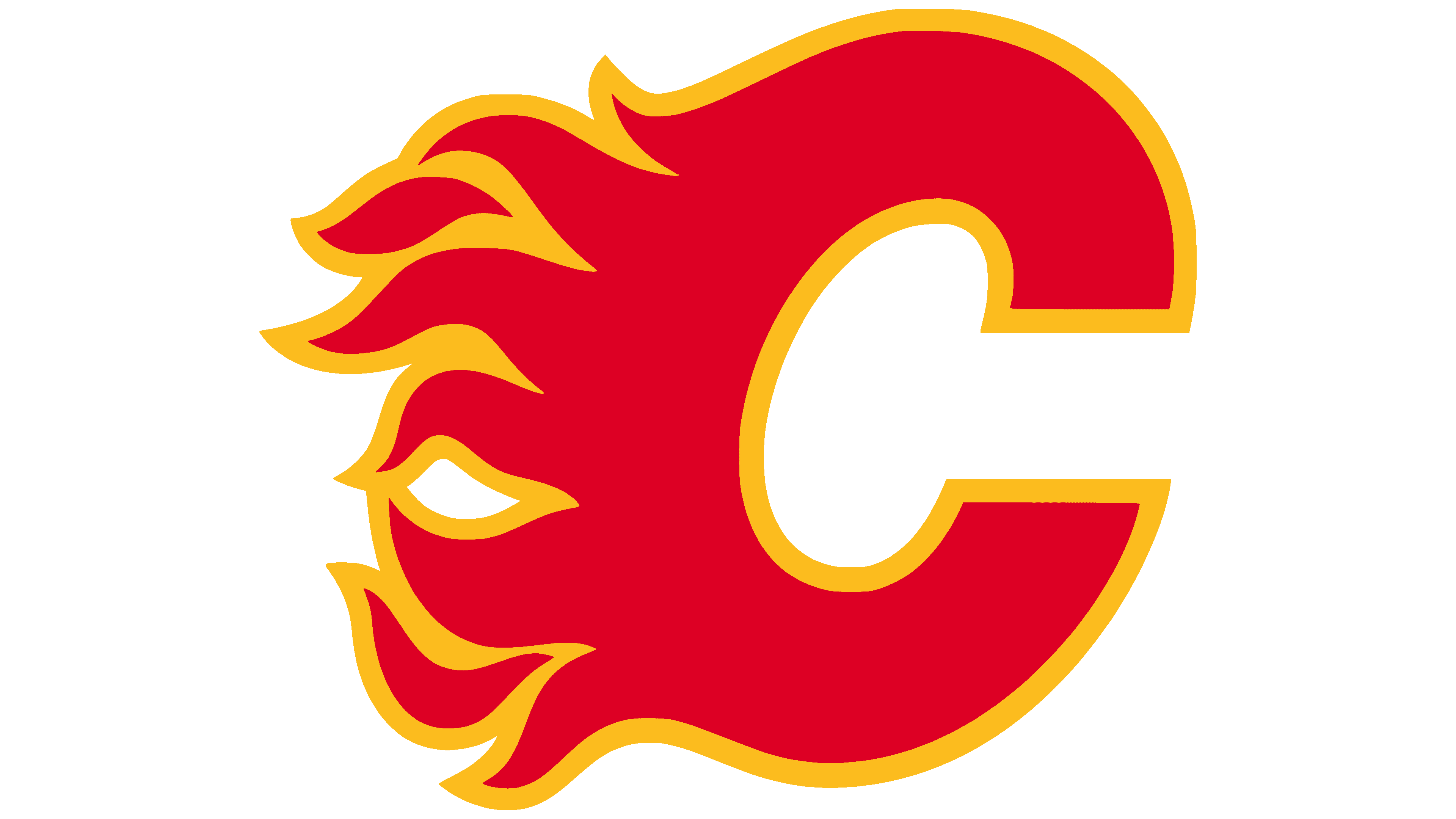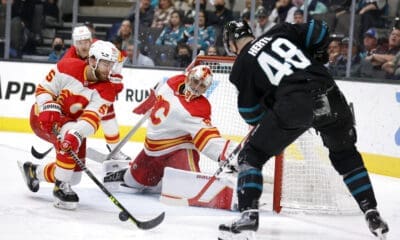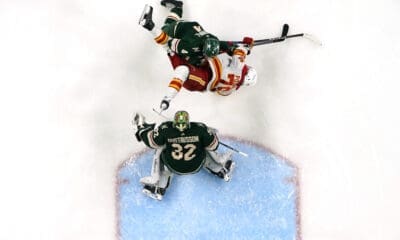Calgary Flames
Jarome Iginla and the “Better Linemates” Myth?

Iginla didn’t have a great goal-scoring year last year either – he was down to 35 from 50. However, he did earn 54 assists and a lot of them came because he was playing on a line with Michael Cammalleri.
If the decision is made to keep Iginla, then the Flames need to find someone like Cammalleri, or even like Alex Tanguay, for Iginla to play with. Tanguay, unlike Cammalleri, was more of a playmaker than a scorer (and not a centre either, which would be ideal), but he was someone who could find Iginla in the shooting areas on the ice, with those nice soft seeing-eye passes of his. Sure, Tanguay was soft and quiet and not exactly a player in the Mike Keenan/Darryl Sutter mould. But he also set up 99 goals in his two years with the Flames. For a Calgary team that scored only 200 in its first 80 games this year, that sort of production might have made the difference between making and missing the playoffs this year.
Assuming then that the primary off-season goal in Calgary is to find a complementary player for Iginla – centre or left winger – the most logical candidate to trade is defenceman Robyn Regehr. Even after dumping Dion Phaneuf, Calgary is still relatively deep on the blue line, with Bouwmeester, Ian White, Mark Giordano, Cory Sarich and Steve Staois. It no longer conjures up imagines of Montreal’s big three, but it is a serviceable group that could survive the loss of Regehr, its most physical presence. Trading Regehr (and his comparatively modest $4-million annual salary) for a forward of comparable skill and earnings might just be the short-term way to tweak the team, if the decision is made not to go scorched-earth right away. Something to think about anyway. –Eric Duhatschek, The Globe and Mail
We’ve heard the refrain one thousand times before: Find a “#1,” a “playmaking centre” to play with Iginla, to feed him the puck, and he will remain a constant threat, atop of the league in scoring every season. The basis for this theory isn’t unfounded–Iginla hasn’t exactly been blessed with the most high quality teammates, from a counting stats standpoint, throughout his career–but the fact that he has twice managed fifty goals certainly says something of the abilities of his linemates, does it not? Or, as so many have contended, is is just him? There are so many extenuating circumstances that it’s very difficult if not impossible to extrapolate how many goals and points someone like Cammalleri would have had this season had he remained a Flame, and, in turn, how many goals and points Iginla would have had, and if those new totals would have added up to a playoff berth. Of course, it’s always easy to theorize, which has been the basis for so many acquisitions and signings in the past–the Jokinen trade, bringing in Alex Tanguay, bringing in Mike Cammalleri–which haven’t always panned out, for one reason or another.
As we’re all too aware, Iginla experienced a revolving door of linemates this season, especially over the first fifty or so games which he was paired with Olli Jokinen, in an effort to find that elusive “spark,” none of which generated sustainable results. As a result, his quality of teammates suffered significantly. Here is a list of players that rank around Iginla in terms of Quality of Teammates this season:
| Name | Team | GP | TOI/60 | QualTeam |
| Iginla | CGY | 81 | 16.39 | -0.024 |
| Cogliano | EDM | 81 | 12.10 | -0.024 |
| Bourque | CGY | 72 | 13.81 | -0.026 |
| Duchene | COL | 81 | 13.62 | -0.026 |
| Boyes | STL | 82 | 13.1 | -0.032 |
| Tavares | NYI | 77 | 13.36 | -0.033 |
| Kesler | VAN | 80 | 13.86 | -0.038 |
| Jokinen, O. | NYR | 80 | 14.36 | -0.045 |
| Samuelsson | VAN | 73 | 13.59 | -0.048 |
| Ladd | CHI | 81 | 12.82 | -0.053 |
*chart altered to show players who played a minimum of 50 games with over 12 minutes of TOI/60.
Those are all above average-good players right there, but all are playing less and, for the most part, easier minutes in different roles than Iginla, including Bourque.
Not surprisingly, Mike Cammalleri was the premier beneficiary in the QualTeam metric of all Flames forwards last season, when he collected thirty-nine goals, nineteen of which came on the powerplay, and eighty-two points playing alongside Iginla for much of the season. The Flames were one of the best possession teams that season and ranked eighth in the league in goals for, with five 20+ goal scorers on their roster and six including Jokinen. Iginla still managed eighty-nine points that season, a significant enough drop from his previous season's ninety-eight when combined with the fact that he wasn't facing the toughest competition to cause concern.
| Name | GP | G | A | P | PP |
| Iginla | 82 | 35 | 54 | 89 | 10 |
| Cammalleri | 81 | 39 | 43 | 82 | 19 |
| Jokinen | 76 | 29 | 28 | 57 | 9 |
| Langkow | 73 | 21 | 28 | 49 | 4 |
| Bourque | 58 | 21 | 19 | 40 | 0 |
| Moss | 81 | 20 | 19 | 39 | 8 |
In 2007/08, Iginla's career season, his teammates fared much better, overall and better than him, in terms of Quality of Teammates, keeping in mind his frequent linemates Langkow and Huselius were coming off career seasons of their own in 2006-07 and still putting up good numbers:
| Name | Team | GP | TOI/60 | QualTeam |
| Langkow | CGY | 80 | 14.09 | 0.439 |
| Spezza | OTT | 76 | 15.36 | 0.428 |
| Plekanec | MTL | 81 | 12.29 | 0.427 |
| Huselius | CGY | 81 | 13.33 | 0.425 |
| Bertuzzi | ANA | 68 | 12.5 | 0.425 |
| Perry | ANA | 70 | 14.08 | 0.419 |
| Thornton | SJ | 82 | 15.17 | 0.404 |
| Weiss | FLA | 74 | 13.42 | 0.403 |
| Ribeiro | DAL | 76 | 13.79 | 0.389 |
| Kunitz | ANA | 82 | 12.15 | 0.387 |
| Conroy | CGY | 79 | 12.27 | 0.367 |
| Tanguay | CGY | 78 | 13.58 | 0.354 |
| Iginla | CGY | 82 | 15.93 | 0.336 |
| Name | GP | G | A | P | PP |
| Iginla | 82 | 50 | 48 | 98 | 15 |
| Huselius | 81 | 25 | 41 | 66 | 6 |
| Langkow | 80 | 30 | 35 | 65 | 14 |
| Tanguay | 78 | 18 | 40 | 58 | 3 |
| Lombardi | 82 | 14 | 22 | 36 | 2 |
| Conroy | 79 | 12 | 22 | 34 | 1 |
That year, Craig Conroy and Alex Tanguay faced the toughest comp of all Flames forwards, and both experienced a corresponding dip in points production that was just about equal, as both also missed a few games due to injury. The more I look at these old stats, the more I miss Alex Tanguay.
In 2006-07, a career season for four of his teammates, Iginla managed a career-high 55 assists and 94 points:
| Name | GP | G | A | p | PP |
| Iginla | 70 | 39 | 55 | 94 | 13 |
| Tanguay | 81 | 22 | 59 | 81 | 5 |
| Langkow | 81 | 33 | 44 | 77 | 10 |
| Huselius | 81 | 34 | 43 | 77 | 14 |
| Lombardi | 81 | 20 | 26 | 46 | 5 |
That season was a far cry from 2005-06, when despite winning the division title, the Flames were one of the lowest scoring clubs in the NHL. That was the last time Iginla failed to reach the 70-point plateau, and the jump in points production for Iginla, Langkow, and Huselius between the two seasons is very impressive and likely one of the main reasons why the Flames jumped from third last in the league in scoring to fourteenth, even though their record and overall position in the standings dropped.
| Name | GP | G | A | P | PP |
| Iginla | 82 | 35 | 32 | 67 | 17 |
| Langkow | 82 | 25 | 34 | 59 | 11 |
| Huselius | 78 | 20 | 27 | 47 | 8 |
Despite having a much deeper and, for the most part, younger lineup this season than in previous seasons, it seems like no coincidence that Iginla struggled this year when the team only had two other 20+ goal scorers up front, one of which, Niklas Hagman, did most of his scoring in 55 games with the Leafs this season, and neither of whom were his regular linemates. Sure, injuries to Daymond Langkow and Curtis Glencross compromised their scoring abilities this season, mid-season trades may have altered the on-ice chemistry, and maybe a few more goals here and there could have been the difference between making and missing the playoffs, but that difference cannot and should not be shouldered solely by the Captain.
Despite his warts, Jarome still led a low-scoring Flames team in goals and points, and he did so without much help from anyone, while playing the toughest minutes of all forwards on the team. The fact that he managed to do just this while operating on the lowest scoring Flames team since 05-06–the last time he failed to reach the 70-point plateau–is no coincidence, and is still as impressive as ever, regardless of any decline in play or the fact that he doesn’t quite stack up against the best in the league as well as he used to. Iginla may no longer be a player who makes his linemates better as much as he is one who is made better by his linemates, and while it is entirely possible that Jarome’s numbers would improve if the Flames managed to sign someone like Patrick Marleau for next season or if he spent a season in Pittsburgh playing alongside Sidney Crosby, I think it ‘s also possible that better seasons out of some of his Flames linemates could have bolstered his counting stats equally.
by Hayley Mutch









